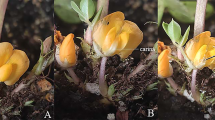Abstract
Six almond progenies, each the product of a cross between a self-compatible and a self-incompatible parent, were analysed for stylar ribonucleases. Proteins were extracted and separated using non-equilibrium pH gradient electrofocusing (NEPHGE), and the gels were stained for ribonuclease activity. Most seedlings showed either two principal bands, interpreted as corresponding to two incompatibility alleles, or a single band. The seedlings were also bagged in the field at flowering time to determine fruit set after selfing, and some were also examined for the growth of pollen-tubes in selfed styles using UV fluorescence microscopy. With very few exceptions, those seedlings showing single-banded zymograms were found to be self-compatible according to field and microscope studies, and those with two bands were found to be self-incompatible. We conclude that the allele for self-compatibility in almond does not code for ribonuclease activity and that the ribonuclease isoenzyme assay is a convenient technique for predicting self-compatibility in segregating progenies. A novel band in two derivatives of ’Ferrastar’ was ascribed to a new incompatibility allele, S 10 .
Similar content being viewed by others
Author information
Authors and Affiliations
Additional information
Received: 19 January 1999 / Accepted: 30 January 1999
Rights and permissions
About this article
Cite this article
Bosković, R., Tobutt, K., Duval, H. et al. A stylar ribonuclease assay to detect self-compatible seedlings in almond progenies. Theor Appl Genet 99, 800–810 (1999). https://doi.org/10.1007/s001220051299
Issue Date:
DOI: https://doi.org/10.1007/s001220051299




